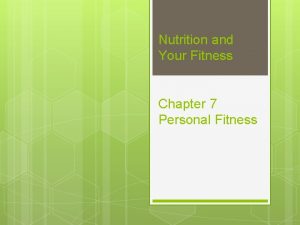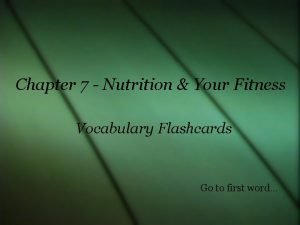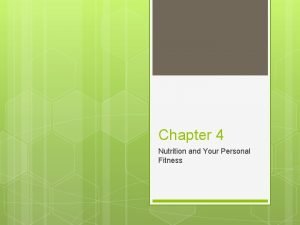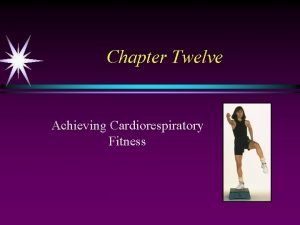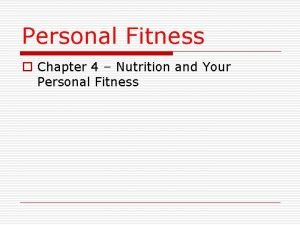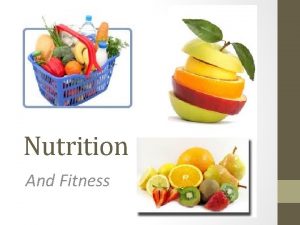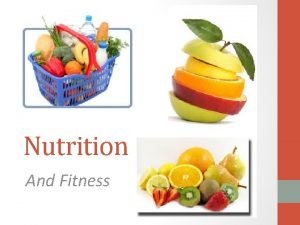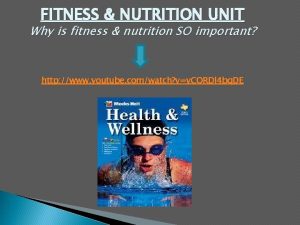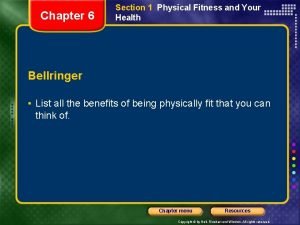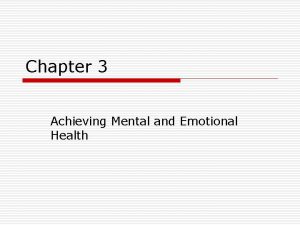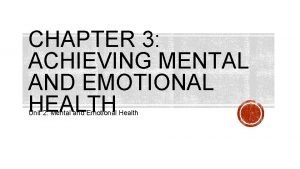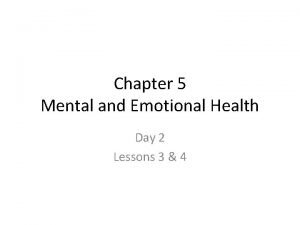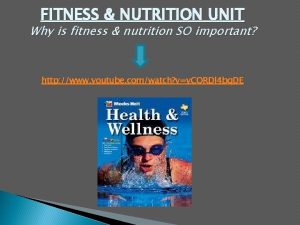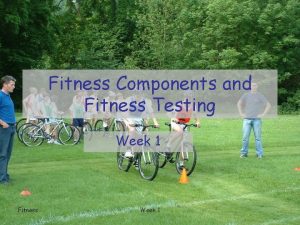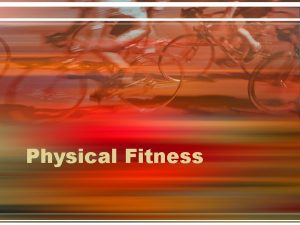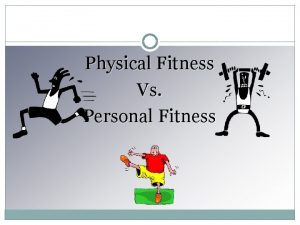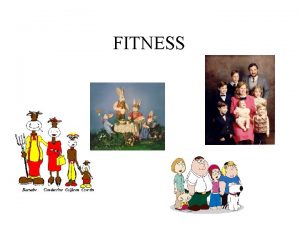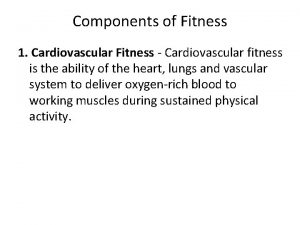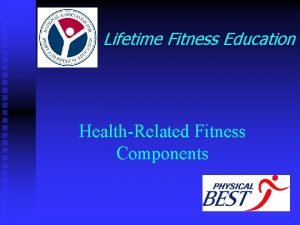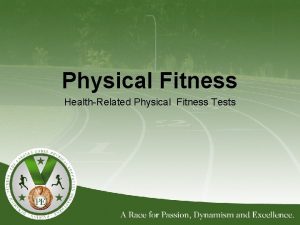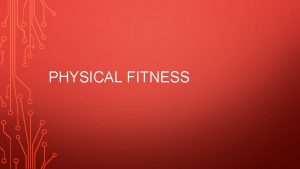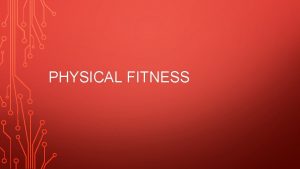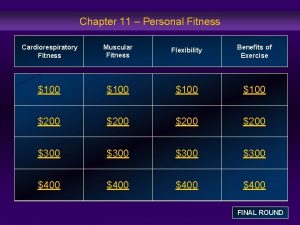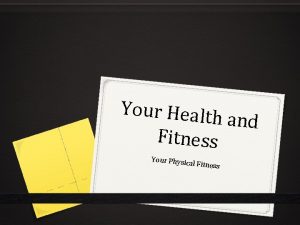Nutrition and Your Fitness Nutrition and Achieving High




























- Slides: 28

Nutrition and Your Fitness

Nutrition and Achieving High Level Fitness Exercise, training, and nutrition helps develop your fitness Nutrition – the process by which the body uses food for maintenance of life, growth, normal functioning of every organ and tissue, and the production of energy Food provides: n n n Fuel (energy) Stamina and vigor for daily activities Basis for sound, healthy skin, teeth, hair, muscles, and bones

Dietary Reference Intake Recommended Dietary Allowance (RDA) n amount necessary to meet nutritional needs Adequate Intake (AI) n guideline used to help set dietary goals Estimated Average Requirement (EAR) n amount needed for special groups Tolerable Upper Level Intake (UL) n the safe upper limits for nutrients

Six Essential Nutrients Carbohydrates Protein Fats Minerals Vitamins Water


Vocab Calorie n Common unit of measurement used to express the potential energy of food Every food you eat contains calories Free Radical n A chemical that causes damage to the cells. Antioxidant n helps prevent and possibly repair damage done to body by the free radicals.

Carbohydrates Function: Major source of energy, in the form of sugar, supplies fiber Food Sources: Fruits, vegetables, grains Recommended Percentage in Diet: 58% or higher n n (48% from complex carbohydrates, 10% from simple) Limit intake of refined carbs (table sugar, sweets, pastries, soft drinks)

Three groups of carbs Monosaccharide (Single sugar) n n Fructose – fruit sugar Glucose – corn sugar Disaccharides (Two sugar) n n n Sucrose – table sugar, cane sugar Lactose – milk sugar Maltose – malt sugar Polysaccharides (Multiple sugars) n n Starch – plant sugars Cellulose – plant fiber

Sugar Intake Eating honey, sugar, soft drinks, candy bars or any sweets does not provide quick energy. To maintain a consistent energy level, eat a diet high in complex carbohydrates (grains, cereals, vegetables)

Proteins Function: Important for growth, maintenance, repair of tissue Food Sources: Chicken, fish, meat, low-fat dairy products, eggs, dried peas, beans Recommended Percentage in Diet: 10 -12%

Amino acids n Building blocks of protein Essential amino acids n Substances making up protein which must be supplied each day by food Complete protein n A protein food which contains all the essential amino acids needed by the body Animal sources of protein are usually complete Plant sources are usually incomplete n Combination of plant sources can be used in diet to form complete protein

Fats Function: Source of stored energy, provide and carry the fat soluble vitamins (ADEK) Food Sources: n n n Monounsaturated fat - olive oil and canola oil, usually liquid and found in vegetables, most healthy type Polyunsaturated fat - safflower oil, margarines, usually liquid and found in vegetables Saturated fat - meat, butter, milk, solid shortenings; usually in solid form and found in animal sources, contribute to heart disease and should be avoided Recommended Percentage in Diet: 20 -30% Fatty acids - Basic building blocks of fats

Cholesterol A waxy, fatty-like material manufactured in the body and used by the body in chemical processes. Found in foods of animal origin. Excess cholesterol is deposited on the lining of the arteries. Narrowing of arteries can lead to cardiovascular problems.

Two Types of Cholesterol High Density Lipoproteins - HDL n Good cholesterol, picks up extra cholesterol and eliminates it from the body Low Density Lipoproteins - LDL n Bad cholesterol, contributes to clogging of arteries by depositing the extra cholesterol on the lining of the arteries

Lipoprotein n Protein wrapped molecule which transports cholesterol and fats through bloodstream Total cholesterol n n n Normal --------- Below 170 Moderately High ------- 170 -199 High ------------Above 200 LDL cholesterol n n n Normal -----------Below 110 Moderately high --------110 -129 High --------------Above 130

Lower your cholesterol Cut back on food high in cholesterol n Eggs, meat, butter, whole milk Avoid trans-fat, which are vegetable oils that have become saturated through hydrogenation n Cocoa butter, coconut and palm oils, lard Avoid meats high in fat (hamburger, sausage, bacon) Reduce saturated fat ( since it raises LDL in your blood)

Fiber Structural part of plants which is neither digested nor absorbed by the body Serves as an intestinal “house cleaner” Ex. Beans, romaine lettuce, brown rice, whole wheat, oranges Fiber is not found in animal foods.

Minerals Function: Important in activating numerous reactions within the body Food Sources: Varies with the specific minerals - a variety of foods is necessary Recommended Percentage in Diet: Adequate intake indicated by the RDA n Balance is important; too much of one mineral can offset functioning of another

Microminerals n Needed in larger quantities (100 milligrams a day) Ex: Sodium, potassium, chloride, calcium, phosphorus, and magnesium Trace minerals n n 14 other minerals Needed in small amounts (few micrograms a day)

Examples of minerals Potassium – regulated balance of fluids, ability for muscles to contract Iron - assists in red blood cell formation Calcium- maintains strong bones and teeth Sodium- helps maintain a proper fluid balance in our blood tissues (sodium and chloride)

Potassium Rich Foods Baked potato with skin --------844 mg Florid avocado --------------742 mg Dried figs -----------------666 mg Raisins -------------------563 mg Cantaloupe ----------------494 mg Orange juice ---------------474 mg Banana -------------------451 mg Spinach -------------------419 mg

Vitamins Function: Aid in absorbing and using the nutrients. Each vitamin has one or more specific functions in the body. Food Sources: Varies with the specific vitamins - a variety of foods is necessary Recommended Percentage in Diet: Adequate intake indicated by the RDA

Fat-soluble Stay stored in your body for awhile (fat tissues and liver) — some stay for a few days, some for up to 6 months Vitamin A n Eyesight. helps you grow properly and aids in healthy skin. Vitamin D n Strong bones and strong teeth. helps your body absorb the amount of calcium it needs. Vitamin E n Maintains a lot of your body's tissues, like the ones in your eyes, skin, and liver. Important for the formation of red blood cells. Vitamin K n Helps clot blood

Water Soluble Dissolve in water and are not stored in the body n Must be in your diet everyday n Can be affected by cooking methods, lost in water they were cooked in Vitamin C n n keeping body tissues, such as gums and muscles in good shape, helps a cut heal, helps your body resist infection. EX: citrus fruits, cantaloupe, strawberries, tomatoes, broccoli, cabbage, kiwi fruit Vitamin B n n n More than one B vitamin. (B 1, B 2, B 6, B 12, etc. ) Helps make energy and set it free when your body needs it. Involved in making red blood cells, which carry oxygen throughout your body. Ex: whole grains, fish and seafood, poultry and meats, eggs, dairy products, leafy green vegetables, beans and peas

Vitamin Supplements If you eat 1200 -1500 calorie diet n n Most likely get adequate supply of vitamins Extra vitamins do not increase strength/endurance, energy, build muscles, or enhance athletic performance Those who may need a vitamin supplement: n n Dieters who take in less than 1, 200 calories People with food allergies who cannot eat certain foods Vegetarians who do not eat animal foods Heavy smokers or heavy drinkers Taking vitamin supplements cannot compensate for a diet that is deficient in nutrients.

Water Function: Provides a medium within the cells in which the chemical reaction of the cells takes place; helps regulate body temperature, digest food, excretion, glandular secretion, formation of blood plasma Food Sources: Beverages and liquids in food Recommended Percentage in Diet: 2 to 3 quarts daily

Essential Questions Ticket Out the Door What are the 6 essential nutrients? What are the functions of the 6 essential nutrients? How can reading a food label determine the value of the food being eaten? • How does marketing affect the foods that consumers eat?

Standards PE. HS. 4. 1 Nutrients-The learner will be able to list the six basic nutrients and understand the function of each PE. HS. 4. 3 Labels-The learner will be able to evaluate nutrition labels and determine the value of the food analyzed. HE. HS. 5. 3 Critical Thinking-The learner will be able to apply critical thinking skills to analyze marketing and advertising methods for influencing food choices.
 Chapter 7 nutrition and your fitness
Chapter 7 nutrition and your fitness Fitness chapter 7
Fitness chapter 7 Chapter 4 nutrition and your personal fitness
Chapter 4 nutrition and your personal fitness Seven fitness nutrition
Seven fitness nutrition Achieving cardiorespiratory fitness can
Achieving cardiorespiratory fitness can Health related skill
Health related skill Achieving your childhood dreams randy pausch
Achieving your childhood dreams randy pausch Fitness & nutrition
Fitness & nutrition Fitness & nutrition
Fitness & nutrition Fitness & nutrition
Fitness & nutrition Fitness & nutrition
Fitness & nutrition Fitness & nutrition
Fitness & nutrition Fitness & nutrition
Fitness & nutrition Fitness & nutrition
Fitness & nutrition Section physical fitness and your health
Section physical fitness and your health Give us your hungry your tired your poor
Give us your hungry your tired your poor Chapter 3 lesson 3 expressing emotions in healthful ways
Chapter 3 lesson 3 expressing emotions in healthful ways Chapter 3 achieving mental and emotional health
Chapter 3 achieving mental and emotional health Glencoe health chapter 3 lesson 1 answers
Glencoe health chapter 3 lesson 1 answers Achieving operational excellence and customer intimacy
Achieving operational excellence and customer intimacy Chapter 3 mental and emotional health answer key
Chapter 3 mental and emotional health answer key Chapter 3 achieving mental and emotional health
Chapter 3 achieving mental and emotional health Emotional health defintion
Emotional health defintion Chapter 15 achieving mental and emotional health
Chapter 15 achieving mental and emotional health Demand uncertainty spectrum
Demand uncertainty spectrum Customer intimacy operational excellence
Customer intimacy operational excellence Scope of strategic fit
Scope of strategic fit Chapter 3 achieving mental and emotional health
Chapter 3 achieving mental and emotional health Chapter 3 achieving mental and emotional health
Chapter 3 achieving mental and emotional health
